Château de Chambord: A royal hunting lodge
The Château de Chambord, one of the grand châteaux in the Loire Valley in France, is a standard stop on many tourist routes, and for good reason. Interesting both for its architecture and its history, its reconstructed rooms display some exceptional works of portraiture as well.
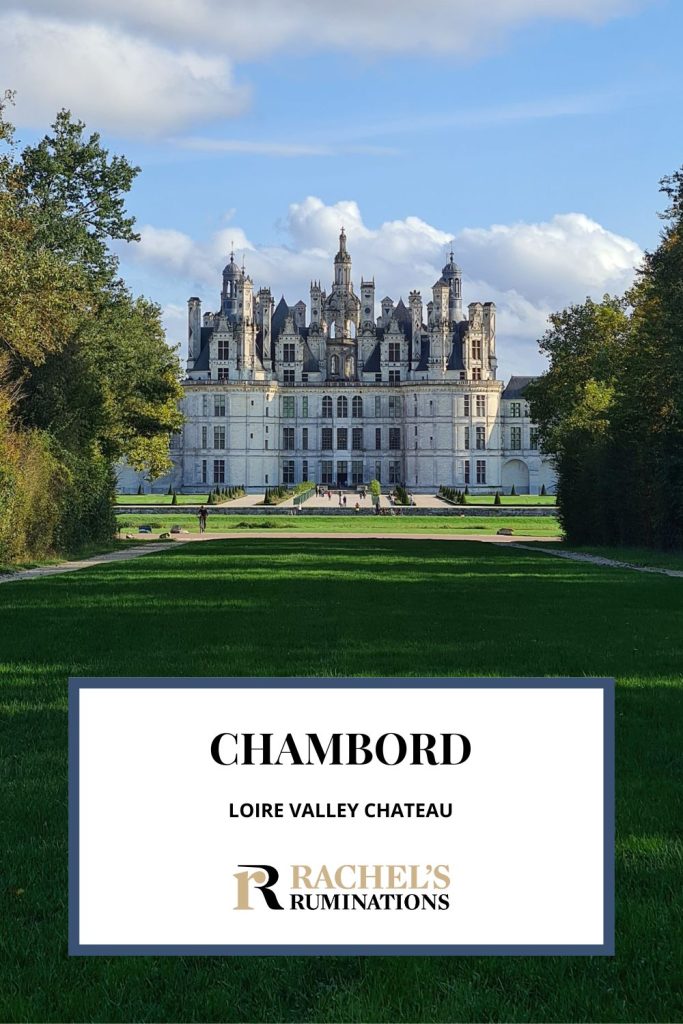
Disclosure: This article contains affiliate links. Purchases made through an affiliate link earn a commission for this website. This will not affect your price.
History of Chambord
Chambord owes its existence to Francis I, who became the king of France in 1515. He intended it to be a hunting lodge, but he only used it a few times. According to Wikipedia, visiting the castle was a massive undertaking requiring thousands of servants. They brought all the furniture as well as all of the food with them. Living in the castle permanently would have been impractical, given how huge it was and hard to heat.
It stood empty for decades, owned by a succession of royalty after Francis’s death: King Henry II, then Gaston d’Orleans (brother of Louis XIII), then Louis XIV. Gaston was the one who restored the castle initially, and Louis XIV restored the keep and furnished it. He actually used the castle each year as a hunting lodge, but stopped in 1685.
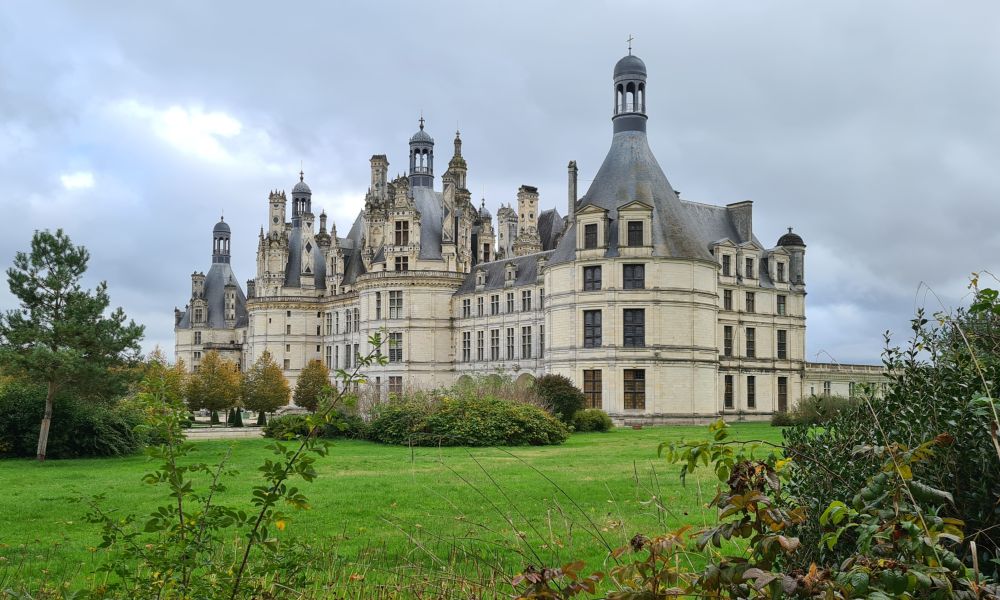
Under Louis XV, Stanislas Leszczynski, Louis XV’s father-in-law and the deposed king of Poland, lived at Chambord from 1725-1733. After that, Louis XV gave the castle to Marechal Maurice de Saxe, whose cavalry regiments also stayed there. De Saxe died in 1750, and again the castle stood empty.
When the French Revolution happened, all the contents of the château were sold, which means what is there now is mostly reconstructions based on early records. They even removed wall panelling and floors.
Napoleon Bonaparte gave the estate to Marechal Louis Alexandre-Berthier, Prince of Wagram, whose widow then put it up for sale. At this point, royalists, through a fundraising drive, managed to buy it and give it to the presumed heir to the royal Bourbon line: Henri, Duke of Bordeaux. His grandfather Charles X had tried to reclaim the throne but had failed, so Henri and the rest of the family lived in exile. Henri only ever visited the castle once. His heirs eventually, in 1930, sold the estate to the government of France.
An interesting side note: Chambord served an important role in World War II when major works of art from museums in Paris, including the Louvre, were sent there for safekeeping.
Chambord’s architecture
The construction of the castle began in 1519, and the keep – the central structure – was completed 20 years later. The rest of the castle wasn’t completed until more than a century later in the 1680s under Louis XIV. It has 440 rooms, according to Wikipedia.
As explained in a short film shown on the ground floor of the keep about the architecture of the building, the design was inspired by medieval castles. This was news to me, since I thought that the general nostalgia for things medieval was a 19th-century thing. I’ve seen it in quite a few 19th-century castles, like Balmoral in Scotland, Castle de Haar in the Netherlands, and Hluboká Castle in Czechia.
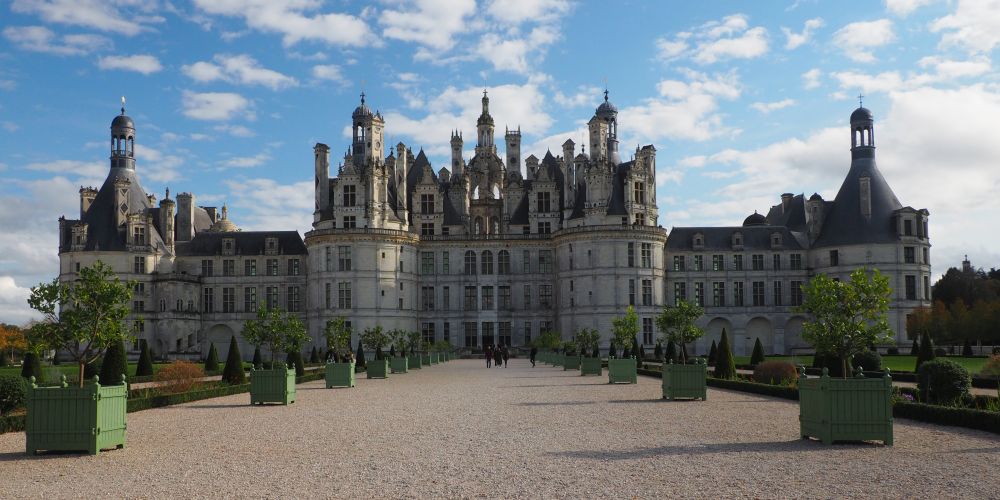
Apparently, though, this grand château for French royalty also references the Middle Ages, but it’s a lot less evident when you look at the place, a thoroughly Renaissance-era confection. The central part of the château is referred to as the keep, just like in a medieval castle, but both inside and outside they are nothing alike. Yet it has large corner bastion towers, a moat, and an outer wall-like building, just like a medieval castle. Clearly none of this was meant for serious defense, with its numerous and large windows.
The roof line is the most decorative part of the outside of the castle. It’s spiky with towers and cupolas and chimneys and such. It surprised me to see, when I viewed the castle from a distance, that they are not symmetrical. As a matter of fact, the entire structure isn’t symmetrical except in terms of its footprint.
Inside the keep
This “keep” is huge, with an elegant double stairway as its centerpiece. The stairway was a relatively new thing at the time of the castle’s 16th-century construction – there’s an earlier one at Blois, 20 km away, but that one is on the outside of the building. This one is central. Leonardo da Vinci may or may not have designed it not long before his death.
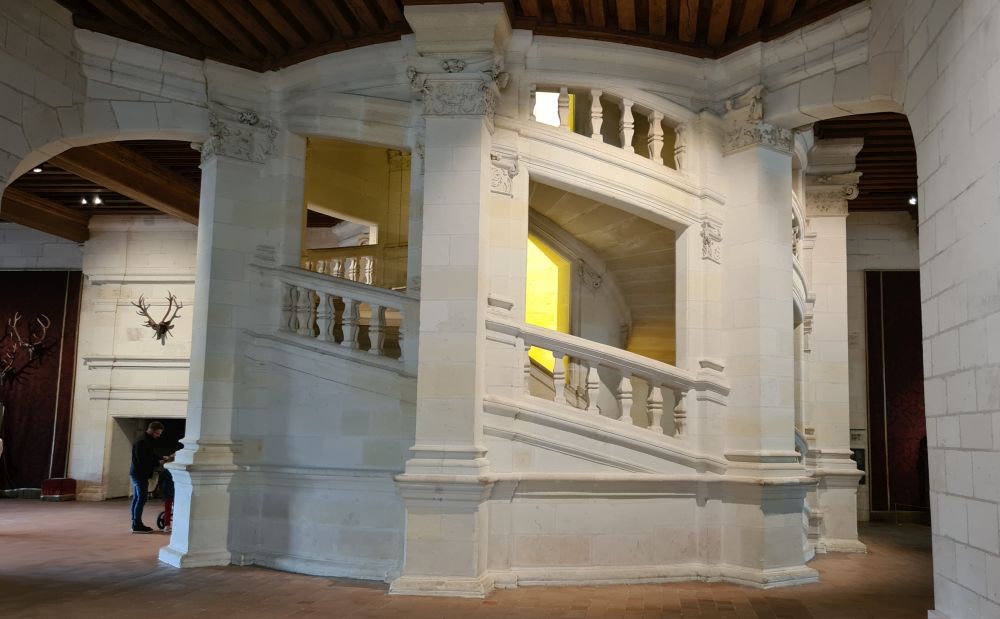
On each floor, then, there are two exits from the stairway, opposite each other. They opened originally to wide, high-ceiling hallways on each floor – a huge x-shaped space with the stairway at its center. Over the centuries, those large spaces on each floor served a number of different purposes: Moliere’s play, Le Bourgeois gentilhomme premiered here in 1670 in front of Louis XIV and his court, for instance. I suppose the main purpose, though, was to impress guests by its sheer size.
The ceilings are very high and with the doors opened to balconies on all four sides, the breeze would have been welcome in the heat of summer, but heating these spaces out of a single fireplace in each hall – four fireplaces per floor – would have taken prodigious quantities of wood, never mind the staff needed to keep them going.
The spaces in each quadrant of the keep, though, were the parts actually used as either reception or living spaces. These were divided into smaller rooms, which presumably would have been easier to heat. Over the centuries, renovations involved lowering some of the ceilings, which would have helped as well.
The outer “wall,” a lower structure surrounding the keep on three sides, originally housed the workspaces: kitchens and storage, for example. Today it’s mostly things like the reception, gift shop and such.
The furnishings
Many of the rooms have been restored, but they vary in terms of time period. For example, Louis XIV’s bedroom is decorated as it was later, when Stanislas Leszczynski used it.
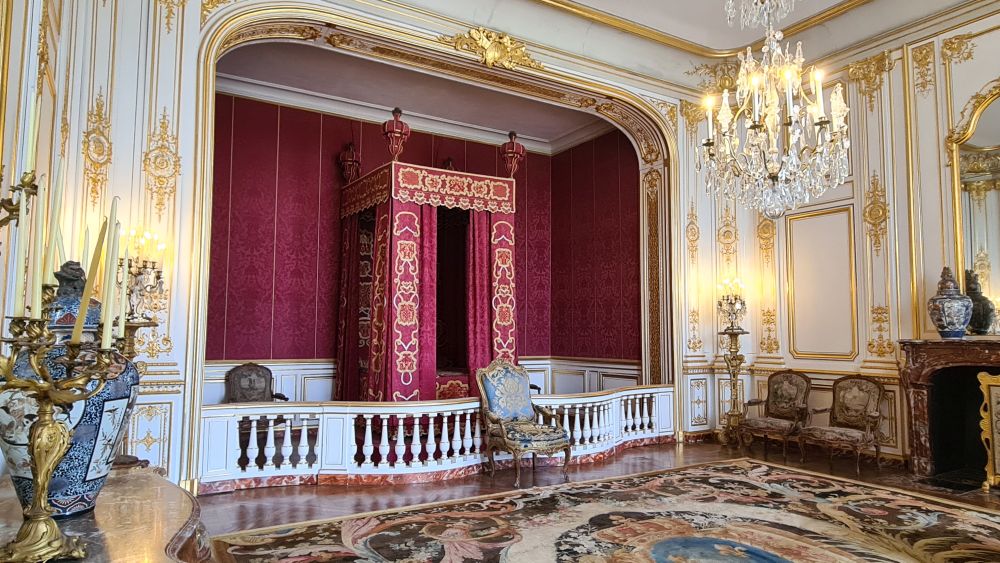
The real highlights of the furnishings, though, are the paintings, most of which are portraits of members of the royal family and other nobility: people like Louis XIV and Marie-Antoinette, for example. Some of these are truly magnificent. And if you are into hunting – or dogs – one room houses a series of images of dogs at various stages of the hunt.
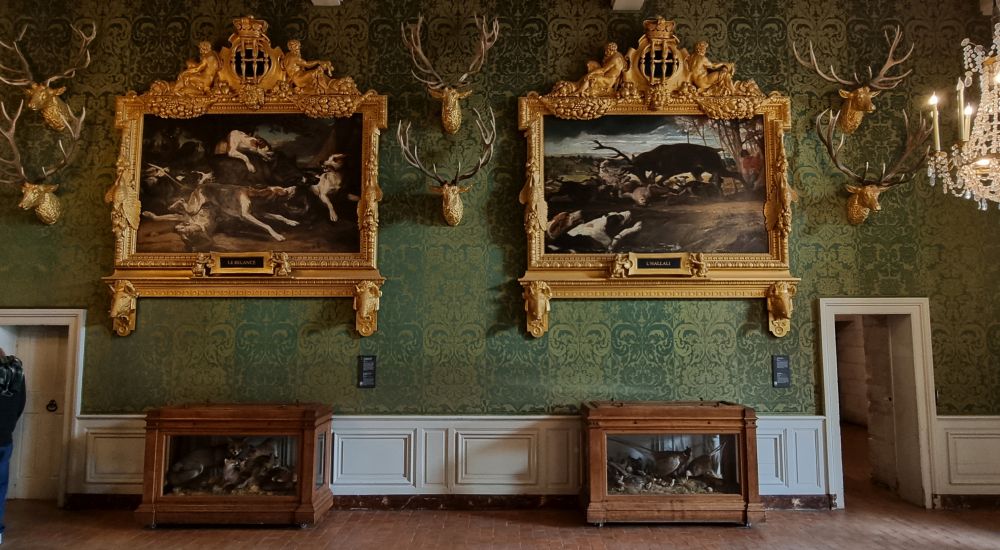
The castle grounds
The estate is huge. The wall surrounding it is 32 kilometers long, enclosing about 13,500 acres (5,440 hectares)! A variety of animal and plant species live here; keep an eye out for stags and wild boars in particular. There’s a reason this estate was originally meant for hunting!
The formal gardens immediately outside the château have been restored to their very elegant, high-maintenance 18th-century plan. Beyond that, it seems to be mostly wooded, and there are paths you can take to stroll or bicycle in the forest.
Where to stay
The nearest hotel to Chateau de Chambord is right inside the park: Relais de Chambord. Staying there would make it easy to take long walks or bike rides on the estate. Otherwise, I’d suggest staying in the town of Blois. It’s a lovely place, and it would enable you to visit Blois Castle easily either first thing in the morning or after going to Chambord. In the evening, consider taking in the Sound & Light show at Blois – it’s great fun. Here’s a map of accommodations in Blois:
Visiting the Chateau de Chambord
You can visit the grounds for free either walking or by bike. To enter the castle and formal gardens, you’ll have to pay an admission fee.
While an audio tour with tablets is available (called HistoPad), you can get the gist of each room by reading the explanatory signs, which are in French and English. You can wander the castle in any order, and a convenient map – definitely necessary because of how easy it is to get disoriented within the divided-up living spaces – points out the things to see if you only have a short time to visit.
If you prefer, at the height of the tourist season there’s a 1-hour guided tour of the castle in English every day at 11:15 for an extra fee. Judging from my visit, though, an hour can only supply a quick overview.
The “Chambord Passport” includes admission to the castle but also adds a horse and birds-of-prey show, plus the HistoPad tour.
Tips for your visit to Chateau de Chambord
Make sure to go up on the roof to take in the view of the formal gardens nearby and the expanse of forest covering the estate.
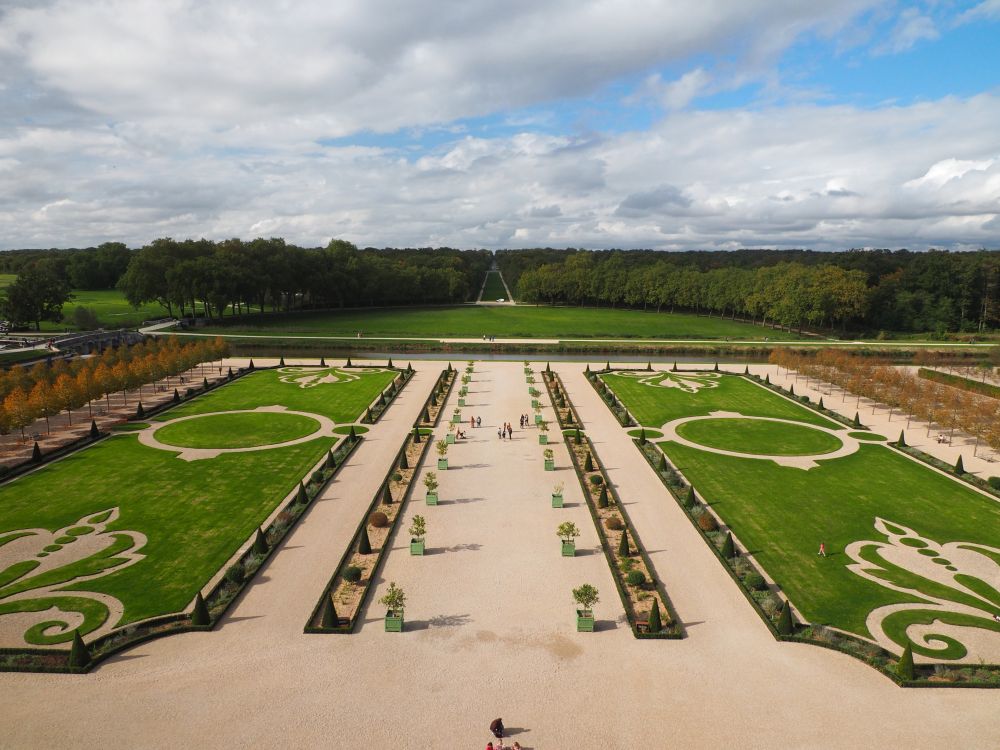
I would say that just to visit the castle, not the grounds, you’d need a good two-three hours. Add more if you want a walk around the estate.
Seeing more than one châteaux in one day is certainly possible. The nearest well-known château is about 20 kilometers away at Blois. You could see them both if you visit one in the morning and one in the afternoon, spending about three hours in each. The drive between them will take less than a half hour. Or you could add Chenonceaux, about an hour’s drive away from Chambord.
Prepare yourself for lots of walking and stair-climbing. This place is big! And if you want to see the formal gardens or stroll the paths around the estate, you’ll walk even more. As an alternative, there are both bicycles and electric golf carts for rent to travel around the very large estate. You could also take a 30-minute boat ride.
If you are wheelchair-bound, you won’t be able to see much. You can see the outside of the castle and move around the grounds. There is a ramp to the ground floor, but as far as I could see there is no way to get to the upper floors without climbing many stairs.
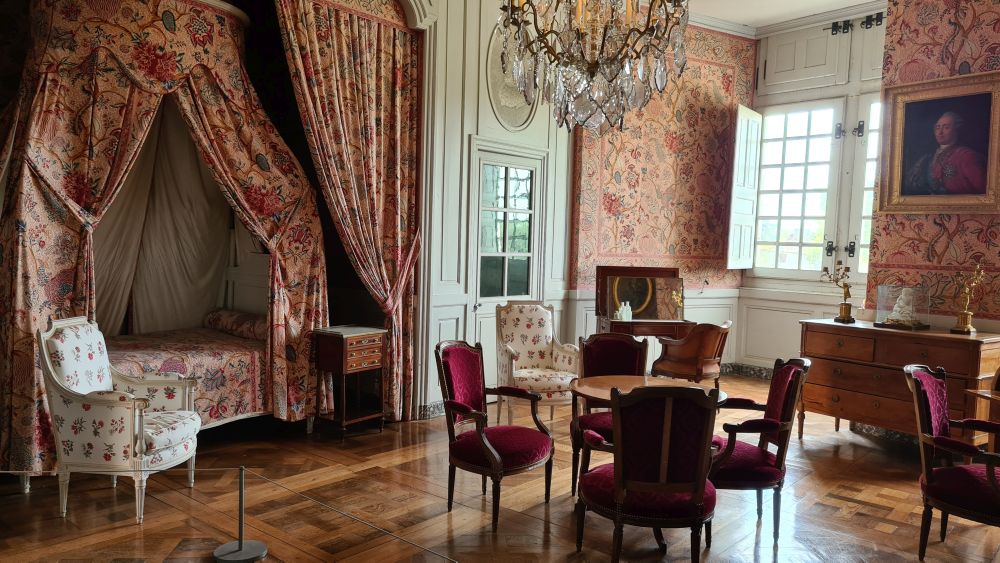
If you drive, parking costs €6 in the nearer parking lot; €5 for the P2 lot further away. During the busiest time of year in the summer, you might have no choice.
The other option is to take a full-day tour, most of which include all transportation and multiple chateaux.
Food and drink are available in the area between the parking lots and the château and in the château itself.
Château de Chambord: About 2 hours’ drive south of Paris or take the train (1 hour and 20 minutes) to the Blois-Chambord station and then a shuttle bus (only April-November) or taxi from there. Open daily 9:00-17:00 in November-March and 9:00-18:00 in April-October. Book your tickets here.
Have you been to Chateau de Chambord? Any tips? And what other chateaux would you recommend? Leave a comment below!
My travel recommendations
Planning travel
- Skyscanner is where I always start my flight searches.
- Booking.com is the company I use most for finding accommodations. If you prefer, Expedia offers more or less the same.
- Discover Cars offers an easy way to compare prices from all of the major car-rental companies in one place.
- Use Viator or GetYourGuide to find walking tours, day tours, airport pickups, city cards, tickets and whatever else you need at your destination.
- Bookmundi is great when you’re looking for a longer tour of a few days to a few weeks, private or with a group, pretty much anywhere in the world. Lots of different tour companies list their tours here, so you can comparison shop.
- GetTransfer is the place to book your airport-to-hotel transfers (and vice-versa). It’s so reassuring to have this all set up and paid for ahead of time, rather than having to make decisions after a long, tiring flight!
- Buy a GoCity Pass when you’re planning to do a lot of sightseeing on a city trip. It can save you a lot on admissions to museums and other attractions in big cities like New York and Amsterdam.
- Ferryhopper is a convenient way to book ferries ahead of time. They cover ferry bookings in 33 different countries at last count.
Other travel-related items
- It’s really awkward to have to rely on WIFI when you travel overseas. I’ve tried several e-sim cards, and GigSky’s e-sim was the one that was easiest to activate and use. You buy it through their app and activate it when you need it. Use the code RACHEL10 to get a 10% discount!
- Another option I just recently tried for the first time is a portable wifi modem by WifiCandy. It supports up to 8 devices and you just carry it along in your pocket or bag! If you’re traveling with a family or group, it might end up cheaper to use than an e-sim. Use the code RACHELSRUMINATIONS for a 10% discount.
- I’m a fan of SCOTTeVEST’s jackets and vests because when I wear one, I don’t have to carry a handbag. I feel like all my stuff is safer when I travel because it’s in inside pockets close to my body.
- I use ExpressVPN on my phone and laptop when I travel. It keeps me safe from hackers when I use public or hotel wifi.


